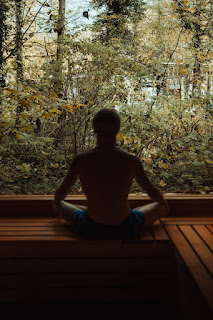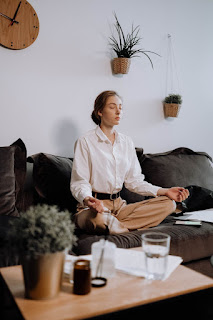Beyond the Mind: An Introduction to Turiya, The Fourth State
A sannyasi (ascetic) meditating by the Ganges; meditation is one path to higher consciousness. Have you ever wondered if there’s more to consciousness than the waking, dreaming, and deep sleep we experience every day? In the teachings of Advaita Vedanta and the Upanishads, there is indeed a “fourth” state of consciousness called Turiya (which literally means “the fourth” in Sanskrit). This fourth state is described as a state of pure awareness that underlies and transcends the other three common states. In simple terms, Turiya is like the silent background of awareness in which waking, dream, and sleep all appear and disappear. In this conversational introduction, we’ll explore what Turiya is according to ancient wisdom (the Mandukya Upanishad and Advaita Vedanta) and insights from sages like Ramana Maharshi, and we’ll look at some simple ways you can begin to explore this state for yourself.
What is Turiya? The “Fourth” State of Consciousness
Turiya is often defined as pure consciousness or the true Self beyond the three usual states of mind. The first three states are familiar to all of us: the waking state (when we are awake and experiencing the external world), the dreaming state (when the mind creates dreams during sleep), and the deep dreamless sleep state (when we have no mental activity and experience darkness or blankness). Turiya is called “the Fourth” because it is a state beyond these three – not a fourth ordinary state, but the background that pervades all three. In Hindu philosophy, Turiya is considered the true Self (Atman) or pure awareness that is constant, while the other states come and go. In fact, Turiya is always present (it’s our essential nature), but we are usually not aware of it because our attention is caught up in the thoughts and perceptions of the other states.
One way to imagine Turiya is as the silent, peaceful witness inside you. For example, when you are awake, you (as consciousness) witness your thoughts and the world; in dreams, that same awareness watches the dream; in deep sleep, the mind rests and there’s no content, yet when you wake up you feel that “I existed” even though you weren’t conscious of anything. According to Advaita Vedanta, that existence or awareness which is present even in deep sleep (albeit without specific experiences) is Turiya the background consciousness. Advaita teacher Rupert Spira puts it simply: the waking, dream, and sleep states all occur as passing phases “over an ever-existent, unchanging background” of consciousness called Turiya. In other words, Turiya is like the screen on which the movie of waking, dreaming, and sleep plays. It is the unchanging awareness that underlies all changing experiences.
Turiya in the Upanishads and Advaita Venana
The sacred syllable Om is used in the Mandukya Upanishad to symbolize all states of consciousness (A, U, M, and the silence after) including the fourth state, Turiya. The concept of Turiya comes from the ancient Hindu scriptures, primarily the Upanishads. In particular, the Māṇḍūkya Upanishad (the shortest Upanishad, with just 12 verses) is famous for its description of the four states of consciousness and the sacred sound Om (AUM).The Mandukya Upanishad explains that the letters of “AUM” represent the three ordinary states “A” for waking, “U” for dreaming, “M” for deep sleep and the silence after the mantra represents Turiya, the fourth, which is pure consciousness.
In the Mandukya Upanishad, Turiya is described as indescribable and beyond ordinary experience. One verse (Mandukya Upanishad, verse 7) says: Turiya is “neither inwardly nor outwardly cognitive… ungraspable, without distinctive marks, unthinkable, and indescribable. It is the cessation of the visible world; it is peaceful, auspicious, and non-dual. That is the Self (Atman) and that is to be realized.”. In simpler terms, this means Turiya is a state of awareness where we are not perceiving objects with the senses or mind, and yet it is not a void either – it is a peaceful, blissful presence, one without a second (meaning it is only pure oneness). This state is the true Self, and realizing it is the goal of Vedanta. The Upanishad emphasizes that “That is the Self, and that is what should be realized.”.
Advaita Vedanta (the philosophy of non-duality) builds on these Upanishadic teachings. According to Advaita Vedanta masters like Gaudapada and Adi Shankara, Turiya is essentially Brahman (the absolute reality) and Atman (the Self) and those are one and the same. They taught that the one pure consciousness (Turiya) is the only reality, and the waking, dream, and deep sleep states are like illusory shadows or projections upon that reality. In other words, our everyday experiences are transient and “unreal” in the ultimate sense, while Turiya is the changeless real nature of everything. One commentary explains that Turiya both transcends and pervades the three states. It’s not just a separate fourth condition, but the foundation present within all states (some teachers even say it is the substratum on which the illusion of the three states appears). Advaita texts often say Turiya is “one without a second,” meaning it is pure oneness with no dualityyogananda.com.au.
Crucially, knowing or realizing Turiya is said to bring about liberation (moksha). When one discovers their Self to be Turiya, the ignorance and illusions drop away. As an example, an Advaita analogy says it’s like realizing that a rope you were afraid of is not a snake – the fear disappears when you see the reality. Similarly, when you realize “I am pure consciousness, not the mind or body”, you no longer cling to external cravings or fearsyogananda.com.au. One text states that when a person realizes his self as Turiya, he is freed from craving for outer objects and from false fears and expectations in lifeyogananda.com.au. The false, changing world is seen like a mirage; and the truth of one’s being as blissful awareness is recognizedyogananda.com.au. Thus, Turiya is not just a philosophical idea it’s considered a state of absolute peace and freedom from suffering.
Ramana Maharshi’s Perspective on Turiya
Ramana Maharshi, a renowned 20th-century Indian sage, often spoke about the nature of the Self and pure awareness, which is essentially the experience of Turiya. While Ramana didn’t always use the word “Turiya” in casual talks, his teachings clearly refer to it. He taught that turiya is in fact our natural state not a mysterious trance or something to be attained anew, but the ever-present awareness that we simply need to recognize by removing our attention from the mind’s distractions. According to Ramana, “Samadhi, Turiya and nirvikalpa [samadhi] all have the same implication that is, awareness of the Self.”. Turiya literally means the fourth state, which he describes as the “supreme consciousness, distinct from the other three states”. He emphasized that the fourth state is eternal, and the other three states come and go in it. In other words, that background awareness (the Self) remains continuous, while waking, dream, and sleep appear and disappear.
Ramana often explained the difference between ordinary deep sleep and the enlightened state of Turiya to illustrate conscious awareness. In deep sleep, we experience a taste of bliss and freedom from worldly worries, but we are unconscious of it at the time. Ramana said that “the bliss which is enjoyed unconsciously in sleep is enjoyed consciously in turiya that is the only difference.”. In Turiya, one is aware of the bliss of the Self even while living life, rather than only experiencing peace when the mind blacks out in deep sleep. Ramana also noted that in Turiya “the mind has merged in its source (the Heart) and is quiescent” meaning the mind is resolved into pure consciousness though a person in Turiya may still appear to function and have some thoughts or sensory activity on the surface.mIt is a state of pure being aware of itself as “I am,” without identification with the body or ego.
Perhaps most importantly, Ramana Maharshi taught a practical path to realize Turiya: self-inquiry (Atma Vichara). His famous question “Who am I?” is a tool to turn awareness back onto itself. By persistently inquiring into the source of the ego and thoughts, the mind subsides into the Heart (pure consciousness). Ramana indicated that the result of this practice is abiding in the natural state of the Self, which is Turiya the only real state. He sometimes called this state the state of “wakeful sleep” or the state beyond waking and sleeping. In fact, he and other teachers have said Turiya is not really one state among others; it is the only state, the ever-present reality, while the others are just appearances. “Turiya is not a state apart from the grosser states but pervades all levels… Ramana Maharshi interprets turiya as the natural state that permeates the other states, the only whole reality.”. In summary, Ramana’s perspective is that you are Turiya – you just need to be still and know yourself as that awareness. His life and teachings are an encouraging reminder that this realization is possible here and now, by turning inward to the core of your being.

Insights from Contemporary Spiritual Teachers
The idea of Turiya might seem abstract, but many modern spiritual teachers discuss it in approachable ways (sometimes using different terms like “pure awareness,” “superconsciousness,” or “presence”). Swami Sivananda, for example, described Turiya as a state in which an individual rests in Sat-Chit-Ananda (“ever-existing, ever-conscious, ever-new bliss”) essentially the experience of the absolute. He said the person in Turiya is in nirvikalpa samadhi, having attained final liberation from the ego and united with the infinite spirit. In this state, one has gone beyond the gross (physical waking) world, the subtle (dream) world, and even the causal (deep sleep darkness). The individual soul realizes its true nature as pure knowledge and bliss, free from all delusion and duality. In other words, Sivananda equated Turiya with the experience of complete enlightenment, a blissful union with the Divine, where the person is liberated from ignorance and lives in the knowledge of the Self.
Another contemporary voice, Sadhguru (a well-known yogi and mystic), speaks about Turiya in the context of yogic science. He explains consciousness in terms of four states and says, “The last state is called turya. This is consciousness where there is no memory involved of any kind.”. By “memory,” he means the impressions, thoughts, and identities from our past experiences. In Turiya, according to Sadhguru, one’s awareness is beyond the conditioning of any memory or past, which makes it a pure intelligence or consciousness. He calls it an “intelligence beyond memory”. This aligns with the idea that Turiya is pure presence, not colored by the mind’s content. Sadhguru often emphasizes that what we call consciousness in yoga is that background of awareness untouched by our mental programming a state where one experiences life directly, without the filter of accumulated impressions. This description helps beginners understand that Turiya is not some far-off mystical trance, but rather a state of clarity where you (as awareness) are free from the clutter of thought and conditioning.
Even outside the Indian tradition, non-dual teachers refer to the essence of Turiya. For instance, the non-duality teacher Rupert Spira uses a metaphor: he says the three states (waking, dream, sleep) are like three images or films playing, and Turiya is the continuous screen or background on which they play. You, as consciousness, are that screen. Likewise, some spiritual authors simply call this the “I Am” presence or “being aware of being aware.” To demystify it: have you ever had a moment of quiet where you felt a sense of “just being”, without getting caught in any thought or role? That gentle aware being is a glimpse of what teachers are pointing to. Contemporary teacher Eckhart Tolle, for example, often speaks about “thoughtless awareness” being fully conscious without the usual mental chatter – which is essentially living in the fourth state. In summary, across different teachers and traditions, the message is that Turiya is a state of full awareness and wholeness. It is always here and now, and by various practices one can realize it. Different teachers may use different words, but they direct us to the same inner experience of pure consciousness that the sages of old called Turiya.
Simple Ways to Begin Exploring Turiya
At first, Turiya might sound very lofty, how can an average person experience this fourth state? While it’s true that Turiya is often fully realized only after dedicated practice or grace, there are simple practices to start exploring the feel of this state. You can think of it as cultivating moments of deep awareness and peace in daily life, which over time can give you insight into the nature of consciousness. Here are a few beginner-friendly approaches:
- Meditation and Self-Inquiry: One of the most direct ways to taste Turiya is through meditation. You can start with a basic mindfulness meditation, sitting quietly and observing your thoughts and sensations without reacting. Notice that you are the witness of whatever thoughts or feelings arise. This witness-consciousness is a doorway to Turiya. As thoughts slow down, try to rest your attention on the feeling of “I Am”, the sense of existing here and now. Sri Ramana Maharshi’s method of asking “Who am I?” and tracing the sense of self back to its source is a powerful practice for this. Whenever a thought or identity arises (e.g., “I am angry” or “I am a student”), ask yourself “Who is aware of this?” or “Who am I?”. This can guide your mind inward toward the silent awareness that is watching. Over time, such self-inquiry leads you to identify less with the mind’s chatter and more with the peaceful awareness behind it. Even a few minutes a day of quietly resting as awareness can give you a glimpse of the serenity associated with Turiya.
- Yogic Sleep (Yoga Nidra): Yoga Nidra is a guided relaxation practice often called “yogic sleep.” It’s a technique where you lie down, relax deeply, yet try to remain consciously aware as the body and mind drift toward sleep. This practice can lead you to experience a state between sleep and wakefulness that is very tranquil and expansive. In fact, some traditions equate the Yoga Nidra state with Turiya. During Yoga Nidra, you might reach a point where the mind is quiet but you (the awareness) are still present this is a taste of conscious deep rest, somewhat akin to the description of Turiya. You can try this by listening to a guided Yoga Nidra recording. The idea is that by training yourself to be aware in a state of deep relaxation (approaching deep sleep consciously), you learn to recognize the “pure awareness” that is independent of the busy mind. As one source describes it, Yoga Nidra is “often referred to as the ‘fourth state’… a state of pure awareness where the individual transcends the mind and experiences a profound sense of unity with the universe.”Don’t worry if you fall asleep at first with practice, you’ll start to notice that part of you is always awake and witnessing, even as the body sleeps. This can be a very calming and illuminating practice.
- Journaling and Self-Reflection: It may not sound as direct as meditation, but journaling can support your exploration of consciousness. Try writing about your experiences of the different states of consciousness. For instance, you could write down what your waking experience is like today, then recall a dream and note how that felt, and then consider the feeling of deep sleep (even though you can’t remember deep sleep, you know after a good deep sleep you felt peaceful and refreshed jot down that impression). Now reflect in your journal with a prompt like: “Is there an unchanging me that was present in all these experiences?” or “Who or what knows these experiences?”. This kind of introspective writing can lead you to intellectually understand the concept of a continuous awareness. You might also journal after meditation: describe the moments when you felt calm awareness. Even asking yourself on paper, “Who am I beyond my thoughts and roles?” and free-writing the answer can be revealing. Such prompts nudge you toward recognizing the observer in you. By regularly writing and reflecting in this way, you cultivate a habit of looking for the background awareness in everyday life. Over time, you start to intuit what Turiya refers to that quiet field of consciousness which has been with you all along.
Remember, the key to all these practices is simplicity and consistency. Turiya is not something you can force or “manufacture”; it’s more about noticing what is already there. In the beginning, you might just get brief glimmers – a moment of stillness where you feel “aha, I’m just here, present, and everything is okay.” Treasure those moments of clarity, no matter how short. Even the ancient texts say that by contemplating and witnessing the three states as transitory, one is led to realize the real Self. So during your day, you can also practice a simple habit: be the witness. Whether you are working, studying, or relaxing, occasionally step back internally and observe “I am aware of these thoughts” or “I am the consciousness experiencing this”. This gentle witnessing builds a bridge to the Turiya perspective.
Finally, be patient and kind to yourself. The journey into understanding consciousness is a gradual unfolding. Every night when you go into deep sleep, you are actually touching a semblance of the peace of Turiya the difference, as sages say, is just that you are not aware of it then. With practice, you may begin to experience that peace consciously in meditation or even amidst daily life. Turiya is often described as pure bliss and peace, and even a small taste of it can be transformative, bringing more tranquility and meaning into your life. It’s the state where one feels deeply connected to oneself, to others, and to the whole universe, because it is literally the One consciousness underlying everything.
In conclusion
Turiya is the Fourth state of consciousness, the backdrop of awareness that is your true Self. It might sound mystical, but it’s also very natural it’s who you really are when you peel away the layers of thought, memory, and sleep. Through simple practices like meditation, yoga nidra, and self-reflection, you can begin to get familiar with this state. The ancient Upanishad declares, “That is the Self, and that is to be realized” meaning that this state of pure consciousness is in fact you, and realizing it is the ultimate goal. But even as a beginner, you can start taking small steps inward. Over time, those steps can lead to a profound discovery: that the peace, clarity, and bliss you seek outside have been within you as the Turiya state all along. Enjoy the journey of exploration, and remember that the background awareness is with you right now as you read these words. In a very real sense, you have never left Turiya you’ve only been unaware of it. Waking up to that awareness is what the spiritual path is all about. Happy exploring!






